C语言栈和队列的基本操作
- 格式:doc
- 大小:1.09 MB
- 文档页数:20

c语言队列的实现以及操作摘要: 队列是数据结构中的一种,在实际生活中也有广泛的应用,本文通过介绍c语言的相关基础知识和算法,实现基本的队列结构以及其中的插入,删除,遍历,清空操作。
关键词:C语言;实现;队列;操作队列是数据结构中的一种,它按照先进先出的原则存储数据,可以分为循环队列和非循环队列,本文将结合c语言的基础知识,利用简单的算法实现非循环队列以及其中的插入,删除,遍历,清空操作。
一、实现队列1.声明结构体在使用c语言实现队列时,首先需要声明一个结构体Queue来定义队列,并定义队头和队尾指针,表示队列的入口和出口,以及空间的大小容量maxSize,并且用一个数组data[]来存储数据。
struct Queue{int data[maxSize]; //存储数据int front; //队头int rear; //队尾int maxSize; //队列容量};2.初始化队列在进行队列操作之前,我们需要将队列初始化,将队头队尾指针置于初始位置,表示队列为空,并将队列最大容量maxSize赋值。
void InitQueue(Queue *queue){queue->front = 0;queue->rear = 0;queue->maxSize = maxSize;}3.入队操作在进行入队操作时,我们先判断队列是否已满,如果未满,就将数据入队,并将队尾指针加一,否则返回队列已满的错误信息。
bool EnQueue(Queue *queue,int data){if((queue->rear+1)%queue->maxSize == queue->front) //队列满return false;queue->data[queue->rear] = data;queue->rear = (queue->rear+1)%queue->maxSize;return true;}4.出队操作在进行出队操作时,我们先判断队列是否为空,如果不为空,就将队头指针对应的数据出队,并将队头指针加一,否则返回队列已空的错误信息。
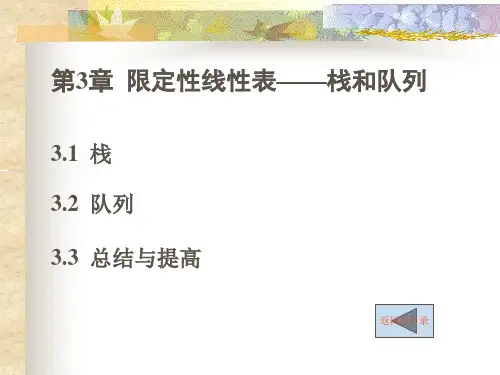
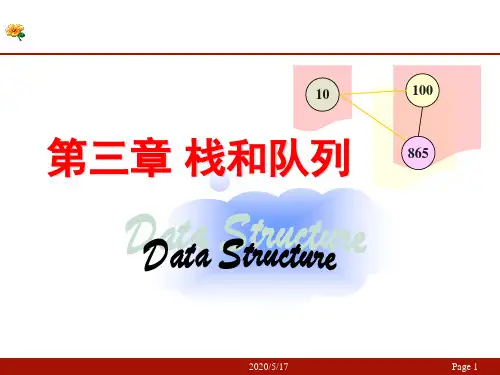
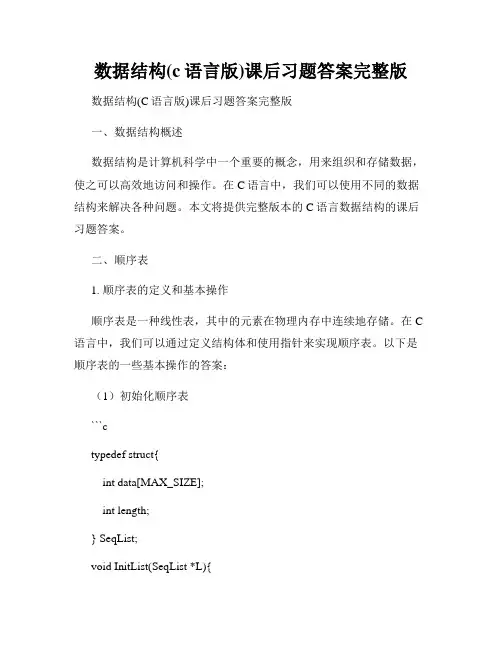
数据结构(c语言版)课后习题答案完整版数据结构(C语言版)课后习题答案完整版一、数据结构概述数据结构是计算机科学中一个重要的概念,用来组织和存储数据,使之可以高效地访问和操作。
在C语言中,我们可以使用不同的数据结构来解决各种问题。
本文将提供完整版本的C语言数据结构的课后习题答案。
二、顺序表1. 顺序表的定义和基本操作顺序表是一种线性表,其中的元素在物理内存中连续地存储。
在C 语言中,我们可以通过定义结构体和使用指针来实现顺序表。
以下是顺序表的一些基本操作的答案:(1)初始化顺序表```ctypedef struct{int data[MAX_SIZE];int length;} SeqList;void InitList(SeqList *L){L->length = 0;}```(2)插入元素到顺序表中```cbool Insert(SeqList *L, int pos, int elem){if(L->length == MAX_SIZE){return false; // 顺序表已满}if(pos < 1 || pos > L->length + 1){return false; // 位置不合法}for(int i = L->length; i >= pos; i--){L->data[i] = L->data[i-1]; // 向后移动元素 }L->data[pos-1] = elem;L->length++;return true;}```(3)删除顺序表中的元素```cbool Delete(SeqList *L, int pos){if(pos < 1 || pos > L->length){return false; // 位置不合法}for(int i = pos; i < L->length; i++){L->data[i-1] = L->data[i]; // 向前移动元素 }L->length--;return true;}```(4)查找顺序表中的元素```cint Search(SeqList L, int elem){for(int i = 0; i < L.length; i++){if(L.data[i] == elem){return i + 1; // 找到元素,返回位置 }}return -1; // 未找到元素}```2. 顺序表习题解答(1)逆置顺序表```cvoid Reverse(SeqList *L){for(int i = 0; i < L->length / 2; i++){int temp = L->data[i];L->data[i] = L->data[L->length - 1 - i]; L->data[L->length - 1 - i] = temp;}}```(2)顺序表元素去重```cvoid RemoveDuplicates(SeqList *L){for(int i = 0; i < L->length; i++){for(int j = i + 1; j < L->length; j++){if(L->data[i] == L->data[j]){Delete(L, j + 1);j--;}}}}```三、链表1. 单链表单链表是一种常见的链式存储结构,每个节点包含数据和指向下一个节点的指针。

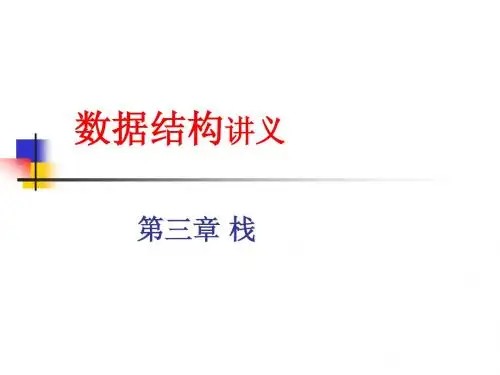
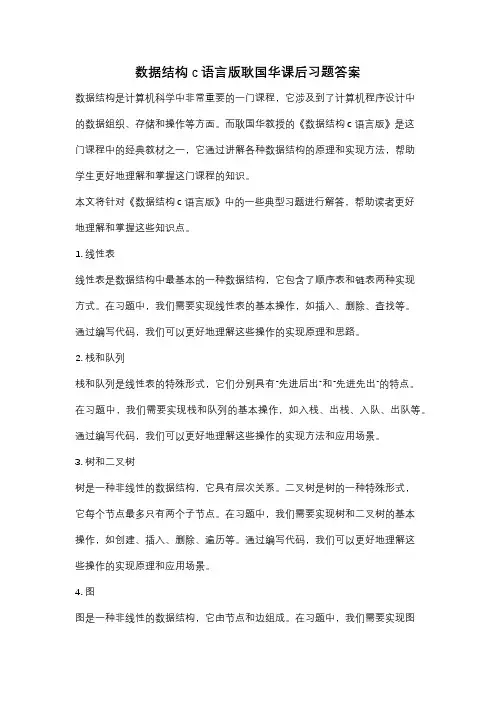
数据结构c语言版耿国华课后习题答案数据结构是计算机科学中非常重要的一门课程,它涉及到了计算机程序设计中的数据组织、存储和操作等方面。
而耿国华教授的《数据结构c语言版》是这门课程中的经典教材之一,它通过讲解各种数据结构的原理和实现方法,帮助学生更好地理解和掌握这门课程的知识。
本文将针对《数据结构c语言版》中的一些典型习题进行解答,帮助读者更好地理解和掌握这些知识点。
1. 线性表线性表是数据结构中最基本的一种数据结构,它包含了顺序表和链表两种实现方式。
在习题中,我们需要实现线性表的基本操作,如插入、删除、查找等。
通过编写代码,我们可以更好地理解这些操作的实现原理和思路。
2. 栈和队列栈和队列是线性表的特殊形式,它们分别具有“先进后出”和“先进先出”的特点。
在习题中,我们需要实现栈和队列的基本操作,如入栈、出栈、入队、出队等。
通过编写代码,我们可以更好地理解这些操作的实现方法和应用场景。
3. 树和二叉树树是一种非线性的数据结构,它具有层次关系。
二叉树是树的一种特殊形式,它每个节点最多只有两个子节点。
在习题中,我们需要实现树和二叉树的基本操作,如创建、插入、删除、遍历等。
通过编写代码,我们可以更好地理解这些操作的实现原理和应用场景。
4. 图图是一种非线性的数据结构,它由节点和边组成。
在习题中,我们需要实现图的基本操作,如创建、插入、删除、遍历等。
通过编写代码,我们可以更好地理解这些操作的实现方法和应用场景。
5. 查找和排序查找和排序是数据结构中非常重要的一部分,它们在实际应用中具有广泛的应用。
在习题中,我们需要实现各种查找和排序算法,如顺序查找、二分查找、冒泡排序、快速排序等。
通过编写代码,我们可以更好地理解这些算法的实现原理和性能特点。
通过以上习题的解答,我们可以更好地理解和掌握《数据结构c语言版》中的知识点。
同时,通过编写代码,我们可以锻炼自己的编程能力和解决问题的能力。
希望读者能够通过习题的解答,更好地理解和应用数据结构这门课程的知识。
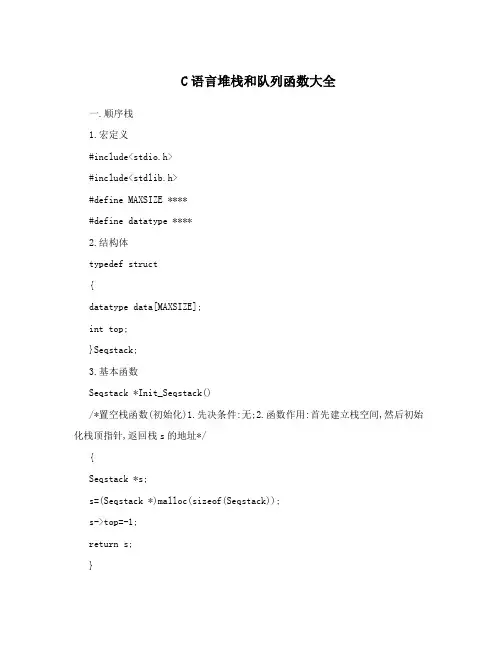
C语言堆栈和队列函数大全一.顺序栈1.宏定义#include<stdio.h>#include<stdlib.h>#define MAXSIZE ****#define datatype ****2.结构体typedef struct{datatype data[MAXSIZE];int top;}Seqstack;3.基本函数Seqstack *Init_Seqstack()/*置空栈函数(初始化)1.先决条件:无;2.函数作用:首先建立栈空间,然后初始化栈顶指针,返回栈s的地址*/{Seqstack *s;s=(Seqstack *)malloc(sizeof(Seqstack));s->top=-1;return s;}int Empty_Seqstack(Seqstack *s) /*判栈空函数1.先决条件:初始化顺序栈;2.函数作用:判断栈是否为空,空返回1,不空返回0*/ {if(s->top==-1) return 1;else return 0;}int Push_Seqstack(Seqstack *s,datatype x) /*入栈函数1.先决条件:初始化顺序栈2.函数作用:将数据x入栈,栈满则不能,成功返回1,因栈满失败返回0*/ {if(s->top==MAXSIZE-1)return 0;s->top=s->top+1;s->data[s->top]=x;return 1;}int Pop_Seqstack(Seqstack *s,datatype *x) acidity, mL.; M--calibration of the molar concentration of sodium hydroxide standard solution, moI/L; V--amount of the volume of sodium hydroxide standard solution, Ml; M--the weight of the sample, g. Such as poor meets the requirements, take the arithmetic mean of the second determination as a result. Results one decimal. 6, allowing differential analyst simultaneously or in quick succession for the second determination, the absolute value of the difference of the results. This value should be no more than 1.0. 1, definitions and principles for determination of ash in starches, starch and ash: starch samples of ash the residue obtainedafter weight. Original sample residue weight of sample weight or weight expressed as a percentage of the dry weight of the sample. Samples ofash at 900 ? high temperature until ashing sample ... The Crucible: determination of Platinum or other conditions of the affected material, capacity of 50mL. Dryer: has effectively adequate drying agent and-perforated metal plate or porcelain. Ashing furnaces: device for controlling and regulating temperature, offers 900 incineration temperature of 25 c. Analytical balance. Electric hot plate or Bunsen. 3, crucible of analysis steps preparation: Crucible must first wash with boiling dilute hydrochloric acid, then wash with a lot of water and then rinse with distilled water. Wash the Crucible within ashing furnace, heated at 900 to 25 ? 30min, and in the desiccator to cool to room temperature and then weighing,/*出栈函数1.先决条件:初始化顺序栈2.函数作用:从栈中出一个数据,并将其存放到x中,成功返回1,因栈空失败返回0*/{if(s->top==-1)return 0;*x=s->data[s->top];s->top--;return 1;}int Top_Seqstack(Seqstack *s,datatype *x)/*取栈顶元素函数1.先决条件:初始化顺序栈2.函数作用:取栈顶元素,并把其存放到x中,成功返回1,因栈空失败返回0*/{if(s->top==-1)return 0;*x=s->data[s->top];return 1;}int Printf_Seqstack(Seqstack *s) /*遍历顺序栈函数1.先决条件:初始化顺序栈2.函数作用:遍历顺序栈,成功返回1*/ {int i,j=0;for(i=s->top;i>=0;i--){printf("%d ",s->data[i]);/*因datatype不同而不同*/j++;if(j%10==0)printf("\n");}printf("\n");return 1;}int Conversation_Seqstack(int N,int r) /*数制转换函数(顺序栈)1.先决条件:具有置空栈,入栈,出栈函数2.函数作用:将N转换为r进制的数*/{Seqstack *s;datatype x;printf("%d转为%d进制的数为:",N,r);/*以后可以删除去*/s=Init_Seqstack();do{Push_Seqstack(s,N%r);N=N/r;acidity, mL.; M--calibration of the molar concentration of sodium hydroxide standard solution, moI/L; V--amount of the volume of sodium hydroxide standard solution, Ml; M--the weight of the sample, g. Such as poor meets the requirements, take the arithmetic mean of the second determination as a result. Results one decimal. 6, allowing differential analyst simultaneously or in quick succession for the second determination, the absolute value of the difference of the results. This value should be no more than 1.0. 1, definitions and principles for determination of ash in starches, starch and ash: starch samples of ash the residue obtained after weight. Original sample residue weight of sample weight or weight expressed as a percentage of the dry weight of the sample. Samples of ash at 900 ? high temperature until ashing sample ... The Crucible: determination of Platinum or other conditions of the affected material, capacity of 50mL. Dryer: has effectivelyadequate drying agent and-perforated metal plate or porcelain. Ashing furnaces: device for controlling and regulating temperature, offers 900 incineration temperature of 25 c. Analytical balance. Electric hot plate or Bunsen. 3, crucible of analysis steps preparation: Crucible mustfirst wash with boiling dilute hydrochloric acid, then wash with a lot of water and then rinse with distilled water. Wash the Crucible within ashing furnace, heated at 900 to 25 ? 30min, and in the desiccator to cool to room temperature and then weighing,}while(N);while(Pop_Seqstack(s,&x)){if(x>=10)/*为了能转为十进制以上的*/printf("%c",x+55);elseprintf("%d",x);}free(s);/*释放顺序栈*/printf("\n");return 1;}4.主函数int main(){Seqstack *s;int choice;datatype x;do{printf("************************************************************ ****\n");printf("1.置空栈 2.判栈空 3.入栈 4.出栈 5.取栈顶元素 6.遍历 7.退出\n");printf("************************************************************ ****\n");printf("请输入选择(1~7):");scanf("%d",&choice);getchar();switch(choice){case 1:s=Init_Seqstack();if(s)printf("置空栈成功!\n");break;case 2:if(Empty_Seqstack(s))printf("此为空栈.\n");elseprintf("此不为空栈.\n");;break;case 3:printf("请输入一个整数:");scanf("%d",&x);if(Push_Seqstack(s,x))printf("入栈成功.\n");elseprintf("栈已满,无法入栈.\n");;break;case 4:if(Pop_Seqstack(s,&x)) acidity, mL.; M--calibration of the molar concentration of sodium hydroxide standard solution, moI/L; V--amount of the volume of sodium hydroxide standard solution, Ml; M--the weight of the sample, g. Such as poor meets the requirements, take the arithmetic mean of the second determination as a result. Results one decimal. 6, allowing differential analyst simultaneously or in quick succession for the second determination, the absolute value of the difference of the results. This value should be no more than 1.0. 1, definitions and principles for determination of ash in starches, starch and ash: starch samples of ash the residue obtained after weight. Original sample residue weight of sample weight or weight expressed as a percentage of the dry weight of the sample. Samples of ash at 900 ? high temperature until ashing sample ... The Crucible: determination of Platinum or other conditions of the affected material, capacity of 50mL. Dryer: has effectively adequate drying agent and-perforated metal plate or porcelain. Ashing furnaces: device for controlling and regulating temperature, offers 900 incineration temperature of 25 c. Analytical balance. Electric hot plate or Bunsen. 3, crucible of analysis steps preparation: Crucible must first wash with boiling dilute hydrochloric acid, then wash with a lot of water and then rinse with distilled water.Wash the Crucible within ashing furnace, heated at 900 to 25 ? 30min, and in the desiccator to cool to room temperature and then weighing, printf("出栈成功,出栈元素为:%d\n",x);elseprintf("出栈失败,因栈为空.\n");break;case 5:if(Top_Seqstack(s,&x))printf("取栈顶元素成功,栈顶元素为:%d\n",x);elseprintf("取栈顶元素失败,因栈为空.\n");break;case 6:Printf_Seqstack(s);break;case 7:printf("谢谢使用!\n");break;default :printf("输入错误,请重新输入!\n");break;}}while(choice!=7);return 0;}二.链栈1.宏定义#include<stdio.h>#include<stdlib.h>#define datatype ****2.结构体typedef struct snode{datatype data;struct snode *next;}Stacknode,*Linkstack;3.基本函数Linkstack Init_Linkstack()/*初始化栈函数1.先决条件:无2.函数作用:初始化链栈,返回top地址*/ { Linkstack top;top=(Linkstack)malloc(sizeof(Stacknode));top->next=NULL;return top;}int Empty_Linkstack(Linkstack top) /*判栈空函数1.先决条件:初始化链栈2.函数作用:判断栈是否为空,空返回1,不空返回0*/{if(top->next==NULL)acidity, mL.; M--calibration of the molar concentration of sodium hydroxide standard solution, moI/L; V--amount of the volume of sodium hydroxide standard solution, Ml; M--the weight of the sample, g. Such as poor meets the requirements, take the arithmetic mean of the second determination as a result. Results one decimal. 6, allowing differential analyst simultaneously or in quick succession for the second determination, the absolute value of the difference of the results. This value should be no more than 1.0. 1, definitions and principles fordetermination of ash in starches, starch and ash: starch samples of ash the residue obtained after weight. Original sample residue weight of sample weight or weight expressed as a percentage of the dry weight of the sample. Samples of ash at 900 ? high temperature until ashing sample ... The Crucible: determination of Platinum or other conditions of the affected material, capacity of 50mL. Dryer: has effectively adequate drying agent and-perforated metal plate or porcelain. Ashing furnaces: device for controlling and regulating temperature, offers 900 incineration temperature of 25 c. Analytical balance. Electric hot plate or Bunsen. 3, crucible of analysis steps preparation: Crucible mustfirst wash with boiling dilute hydrochloric acid, then wash with a lot of water and then rinse with distilled water. Wash the Crucible within ashing furnace, heated at 900 to 25 ? 30min, and in the desiccator to cool to room temperature and then weighing,return 1;else return 0;}int Push_Linkstack(Linkstack top,datatype x) /*入栈函数1.先决条件:初始化链栈2.函数作用:将数据x入栈,成功返回1,失败返回0*/ { Stacknode *p;p=(Stacknode *)malloc(sizeof(Stacknode));p->data=x;p->next=top->next;top->next=p;return 1;}int Pop_Linkstack(Linkstack top,datatype *x) /*出栈函数1.先决条件:初始化链栈2.函数作用:若栈空退出,若没空则将数据出栈,并将其存放到x中,成功返回1,因栈空失败返回0*/{if(top->next==NULL)return 0;Stacknode *p=top->next;*x=p->data;top->next=p->next;free(p);return 1;}int Top_Linkstack(Linkstack top,datatype *x) /*取栈顶元素函数1.先决条件:初始化链栈2.函数作用:取栈顶元素并放到x中,成功返回1,因栈空失败返回0*/{if(top->next==NULL)return 0;*x=top->next->data;return 1;}int Printf_Linkstack(Linkstack top) /*遍历链栈函数1.先决条件:初始化链栈2.函数作用:遍历链栈,成功返回1*/ {Stacknode *p=top->next;int j=0;while(p){printf("%d ",p->data);/*因datatype不同而不同*/j++;if(j%10==0)acidity, mL.; M--calibration of the molar concentration of sodium hydroxide standard solution, moI/L; V--amount of the volume of sodium hydroxide standard solution, Ml; M--the weight of the sample, g. Such as poor meets the requirements, take the arithmetic mean of the second determination as a result. Results one decimal. 6, allowing differential analyst simultaneously or in quick succession for the second determination, the absolute value of the difference of the results. This value should be no more than 1.0. 1, definitions and principles for determination of ash in starches, starch and ash: starch samples of ash the residue obtained after weight. Original sample residue weight of sample weight or weight expressed as a percentage of the dry weight of the sample. Samples of ash at 900 ? high temperature until ashing sample ... The Crucible: determination of Platinum or other conditions of the affected material, capacity of 50mL. Dryer: has effectively adequate drying agent and-perforated metal plate or porcelain. Ashingfurnaces: device for controlling and regulating temperature, offers 900 incineration temperature of 25 c. Analytical balance. Electric hot plate or Bunsen. 3, crucible of analysis steps preparation: Crucible mustfirst wash with boiling dilute hydrochloric acid, then wash with a lot of water and then rinse with distilled water. Wash the Crucible within ashing furnace, heated at 900 to 25 ? 30min, and in the desiccator to cool to room temperature and then weighing,printf("\n");p=p->next;}printf("\n");return 1;}int Conversation_Linkstack(int N,int r)/*数制转换函数(链栈)1.先决条件:具有置空栈,入栈,出栈函数2.函数作用:将N转换为r进制的数*/{Linkstack top;datatype x;printf("%d转为%d进制的数为:",N,r);/*以后可以删除去*/top=Init_Linkstack();do{Push_Linkstack(top,N%r);N=N/r;}while(N);while(Pop_Linkstack(top,&x)){if(x>=10)/*为了能转为十进制以上的*/printf("%c",x+55);elseprintf("%d",x);}printf("\n");free(top);/*释放栈顶空间*/return 1;}4.主函数int main(){Linkstack top;int choice;datatype x;do{printf("************************************************************ ****\n");printf("1.置空栈 2.判栈空 3.入栈 4.出栈 5.取栈顶元素 6.遍历 7.退出\n");printf("************************************************************ ****\n");printf("请输入选择(1~7):");acidity, mL.; M--calibration of the molar concentration of sodium hydroxide standard solution, moI/L; V--amount of the volume of sodium hydroxide standard solution, Ml; M--the weight of the sample, g. Such as poor meets the requirements, take the arithmetic mean of the second determination as a result. Results one decimal. 6, allowing differential analyst simultaneously or in quick succession for the second determination, the absolute value of the difference of the results. This value should be no more than 1.0. 1, definitions and principles for determination of ash in starches, starch and ash: starch samples of ash the residue obtained after weight. Original sample residue weight of sample weight or weight expressed as a percentage of the dry weight of the sample. Samples of ash at 900 ? high temperature until ashing sample ... The Crucible: determination of Platinum or other conditions of the affected material, capacity of 50mL. Dryer: has effectively adequate drying agent and-perforated metal plate or porcelain. Ashing furnaces: device for controlling and regulating temperature, offers 900 incineration temperature of 25 c. Analytical balance. Electric hot plate or Bunsen. 3, crucible of analysis steps preparation: Crucible mustfirst wash with boiling dilute hydrochloric acid, then wash with a lotof water and then rinse with distilled water. Wash the Crucible within ashing furnace, heated at 900 to 25 ? 30min, and in the desiccator to cool to room temperature and then weighing,scanf("%d",&choice);getchar();switch(choice){case 1:top=Init_Linkstack();if(top)printf("置空栈成功!\n");break;case 2:if(Empty_Linkstack(top))printf("此为空栈.\n");elseprintf("此不为空栈.\n");;break;case 3:printf("请输入一个整数:");scanf("%d",&x);if(Push_Linkstack(top,x))printf("入栈成功.\n");elseprintf("栈已满,无法入栈.\n");;break;case 4:if(Pop_Linkstack(top,&x))printf("出栈成功,出栈元素为:%d\n",x);elseprintf("出栈失败,因栈为空.\n");break;case 5:if(Top_Linkstack(top,&x))printf("取栈顶元素成功,栈顶元素为:%d\n",x);elseprintf("取栈顶元素失败,因栈为空.\n");break;case 6:Printf_Linkstack(top);break;case 7:printf("谢谢使用!\n");break;default :printf("输入错误,请重新输入!\n");break;}}while(choice!=7);return 0;}二.队列1.宏定义2.结构体3.基本函数4.主函数acidity, mL.; M--calibration of the molar concentration of sodium hydroxide standard solution, moI/L; V--amount of the volume of sodium hydroxide standard solution, Ml; M--the weight of the sample, g. Such as poor meets the requirements, take the arithmetic mean of the second determination as a result. Results one decimal. 6, allowing differential analyst simultaneously or in quick succession for the second determination, the absolute value of the difference of the results. Thisvalue should be no more than 1.0. 1, definitions and principles for determination of ash in starches, starch and ash: starch samples of ash the residue obtained after weight. Original sample residue weight of sample weight or weight expressed as a percentage of the dry weight of the sample. Samples of ash at 900 ? high temperature until ashing sample ... The Crucible: determination of Platinum or other conditions of the affected material, capacity of 50mL. Dryer: has effectively adequate drying agent and-perforated metal plate or porcelain. Ashing furnaces: device for controlling and regulating temperature, offers 900 incineration temperature of 25 c. Analytical balance. Electric hot plate or Bunsen. 3, crucible of analysis steps preparation: Crucible mustfirst wash with boiling dilute hydrochloric acid, then wash with a lot of water and then rinse with distilled water. Wash the Crucible within ashing furnace, heated at 900 to 25 ? 30min, and in the desiccator to cool to room temperature and then weighing,。
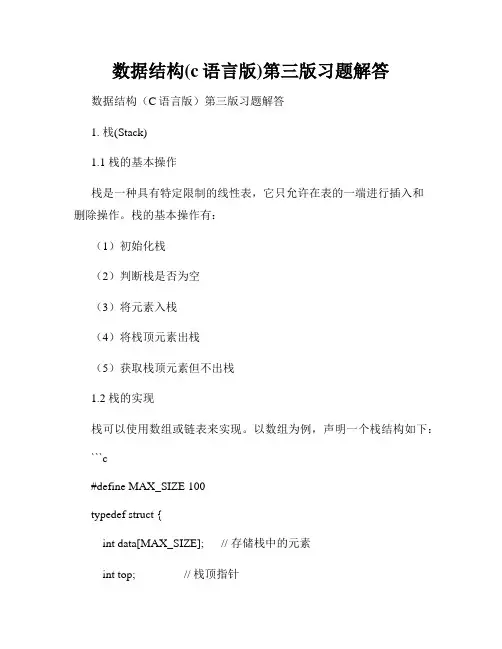
数据结构(c语言版)第三版习题解答数据结构(C语言版)第三版习题解答1. 栈(Stack)1.1 栈的基本操作栈是一种具有特定限制的线性表,它只允许在表的一端进行插入和删除操作。
栈的基本操作有:(1)初始化栈(2)判断栈是否为空(3)将元素入栈(4)将栈顶元素出栈(5)获取栈顶元素但不出栈1.2 栈的实现栈可以使用数组或链表来实现。
以数组为例,声明一个栈结构如下:```c#define MAX_SIZE 100typedef struct {int data[MAX_SIZE]; // 存储栈中的元素int top; // 栈顶指针} Stack;```1.3 栈的应用栈在计算机科学中有广泛的应用,例如计算表达式的值、实现函数调用等。
下面是一些常见的栈应用:(1)括号匹配:使用栈可以检查一个表达式中的括号是否匹配。
(2)中缀表达式转后缀表达式:栈可以帮助我们将中缀表达式转换为后缀表达式,便于计算。
(3)计算后缀表达式:使用栈可以方便地计算后缀表达式的值。
2. 队列(Queue)2.1 队列的基本操作队列是一种按照先进先出(FIFO)原则的线性表,常用的操作有:(1)初始化队列(2)判断队列是否为空(3)将元素入队(4)将队头元素出队(5)获取队头元素但不出队2.2 队列的实现队列的实现一般有循环数组和链表两种方式。
以循环数组为例,声明一个队列结构如下:```c#define MAX_SIZE 100typedef struct {int data[MAX_SIZE]; // 存储队列中的元素int front; // 队头指针int rear; // 队尾指针} Queue;```2.3 队列的应用队列在计算机科学中也有广泛的应用,例如多线程任务调度、缓存管理等。
下面是一些常见的队列应用:(1)广度优先搜索:使用队列可以方便地实现广度优先搜索算法,用于解决图和树的遍历问题。
(2)生产者-消费者模型:队列可以用于实现生产者和消费者之间的数据传输,提高系统的并发性能。

栈的操作(实验报告范文)栈的基本操作,附带源程序实验三栈和队列3.1实验目的:(1)熟悉栈的特点(先进后出)及栈的基本操作,如入栈、出栈等,掌握栈的基本操作在栈的顺序存储结构和链式存储结构上的实现;(2)熟悉队列的特点(先进先出)及队列的基本操作,如入队、出队等,掌握队列的基本操作在队列的顺序存储结构和链式存储结构上的实现。
3.2实验要求:(1)复习课本中有关栈和队列的知识;(2)用C语言完成算法和程序设计并上机调试通过;(3)撰写实验报告,给出算法思路或流程图和具体实现(源程序)、算法分析结果(包括时间复杂度、空间复杂度以及算法优化设想)、输入数据及程序运行结果(必要时给出多种可能的输入数据和运行结果)。
3.3基础实验[实验1]栈的顺序表示和实现实验内容与要求:编写一个程序实现顺序栈的各种基本运算,并在此基础上设计一个主程序,完成如下功能:(1)初始化顺序栈(2)插入元素(3)删除栈顶元素(4)取栈顶元素(5)遍历顺序栈(6)置空顺序栈分析:栈的顺序存储结构简称为顺序栈,它是运算受限的顺序表。
对于顺序栈,入栈时,首先判断栈是否为满,栈满的条件为:p->top==MA某NUM-1,栈满时,不能入栈;否则出现空间溢出,引起错误,这种现象称为上溢。
出栈和读栈顶元素操作,先判栈是否为空,为空时不能操作,否则产生错误。
通常栈空作为一种控制转移的条件。
注意:(1)顺序栈中元素用向量存放(2)栈底位置是固定不变的,可设置在向量两端的任意一个端点(3)栈顶位置是随着进栈和退栈操作而变化的,用一个整型量top (通常称top为栈顶指针)来指示当前栈顶位置参考程序:#include<tdio.h>#include<tdlib.h>#defineMA某NUM20栈的基本操作,附带源程序#defineElemTypeint/某定义顺序栈的存储结构某/ typedeftruct{ElemTypetack[MA某NUM]; inttop;}SqStack;/某初始化顺序栈某/voidInitStack(SqStack某p){if(!p)printf("Eorror");p->top=-1;}/某入栈某/voidPuh(SqStack某p,ElemType某){if(p->top<MA某NUM-1){p->top=p->top+1;p->tack[p->top]=某;}eleprintf("Overflow!\n");}/某出栈某/ElemTypePop(SqStack某p){ElemType某;if(p->top!=0){某=p->tack[p->top];printf("以前的栈顶数据元素%d已经被删除!\n",p->tack[p->top]);p->top=p->top-1;return(某);}ele{printf("Underflow!\n");return(0);}}/某获取栈顶元素某/ ElemTypeGetTop(SqStack某p) {ElemType某;if(p->top!=0){某=p->tack[p->top];return(某);}ele{printf("Underflow!\n");栈的基本操作,附带源程序return(0);}}/某遍历顺序栈某/ voidOutStack(SqStack某p) {inti;if(p->top<0)printf("这是一个空栈!");printf("\n");for(i=p->top;i>=0;i--)printf("第%d个数据元素是:%6d\n",i,p->tack[i]); }/某置空顺序栈某/voidetEmpty(SqStack某p){p->top=-1;}/某主函数某/main(){SqStack某q;inty,cord;ElemTypea;do{printf("\n");printf("第一次使用必须初始化!\n");printf("\n主菜单\n");printf("\n1初始化顺序栈\n");printf("\n2插入一个元素\n");printf("\n3删除栈顶元素\n");printf("\n4取栈顶元素\n");printf("\n5置空顺序栈\n");printf("\n6结束程序运行\n");printf("\n--------------------------------\n"); printf("请输入您的选择(1,2,3,4,5,6)");canf("%d",&cord);printf("\n");witch(cord){cae1:{q=(SqStack某)malloc(izeof(SqStack));InitStack(q);OutStack(q);}break;cae2:栈的基本操作,附带源程序{printf("请输入要插入的数据元素:a="); canf("%d",&a);Puh(q,a);OutStack(q);}break;cae3:{Pop(q);OutStack(q);}break;cae4:{y=GetTop(q);printf("\n栈顶元素为:%d\n",y); OutStack(q);}break;cae5:{etEmpty(q);printf("\n顺序栈被置空!\n"); OutStack(q);}break;cae6:e某it(0);}}while(cord<=6);}[实验2]栈的链式表示和实现实验内容与要求:编写一个程序实现链栈的各种基本运算,并在此基础上设计一个主程序,完成如下功能:(1)初始化链栈(2)链栈置空(3)入栈(4)出栈(5)取栈顶元素(6)遍历链栈分析:链栈是没有附加头结点的运算受限的单链表。
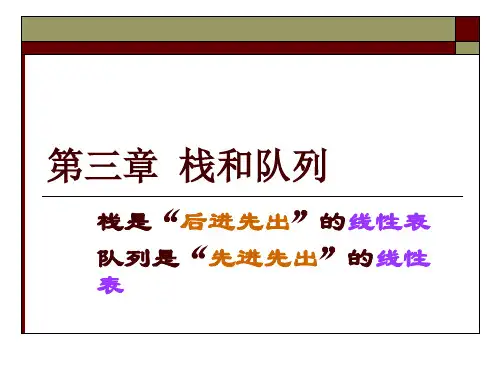
数据结构面试之四——队列的常见操作题注:《面试宝典》有相关习题,但思路相对不清晰,排版有错误,作者对此参考相关书籍和自己观点进行了重写,供大家参考。
四、队列的基本操作1.用数组构造队列队列即是满足先进先出的链表。
用数组存储的话,同样需要满足队列头front出栈,队列末尾rear入栈。
而对于数组来讲,rear和front可以代表数组头和尾。
不能简单的固定rear 和front的大小为maxSize和0,因为可能出现中间元素为空的现象。
所以,对于数组队列来讲,可以想象成环式存储,因为每一次入队后rear+1,每一次出队后front+1。
这就需要控制front和rear的大小,每一次修改只要满足front=(front+1)%maxSize,rear=(rear+1)%maxSize即可满足要求。
同样需要注意:入队操作前先判定队列是否已经满;出队操作前先判定队列是否为空。
template<typename Type>class arrQueue{public:arrQueue(intnSize=100);~arrQueue();arrQueue(constarrQueue<Type>& copyQueue);arrQueue&operator=(const arrQueue<Type>& otherQueue);voidinitializeQueue();void destroyQueue();bool isQueueEmpty();bool isQueueFull();void addQueue(constType& item);void deQueue(Type&deletedItem);private:int maxSize;int rear;int front;Type* list;};template<typename Type>arrQueue<Type>::arrQueue(int nSize=100){if(nSize < 0){nSize = 100;list = newType[nSize];front = 0;rear = 0;maxSize = 100;}else{list = newType[nSize];front = 0;rear = 0;maxSize =nSize;}}template<typename Type>arrQueue<Type>::~arrQueue(){if(!list){delete[]list; //注意数组的删除,为delete []list;list = NULL;}}template<typename Type>arrQueue<Type>::arrQueue(const arrQueue<Type>©Queue){maxSize =copyQueue.maxSize;front =copyQueue.front;rear = copyQueue.rear;list = newType[maxSize]; //注意需要自定义大小,容易出错.for( int i = 0; i <rear; i++){list[i] =copyQueue.list[i];}}template<typename Type>arrQueue<Type>& arrQueue<Type>::operator=(constarrQueue<Type>& otherQueue){if(this ==&otherQueue){cout <<"can't copy oneSelf!" << endl;return *this;}else{if(maxSize !=otherQueue.maxSize){cout<< "The Size of two Queue are not equal!" << endl;return*this;}else{maxSize= otherQueue.maxSize;front =otherQueue.front;rear =otherQueue.rear;for( inti = 0; i < rear; i++){list[i]= otherQueue.list[i]; }//endforreturn*this;}}//end else}template<typename Type>void arrQueue<Type>::initializeQueue(){destroyQueue();}template<typename Type>void arrQueue<Type>::destroyQueue(){front = 0;rear = 0;}//栈空的判定标志rear==front[初始]template<typename Type>bool arrQueue<Type>::isQueueEmpty(){return (rear ==front);}//空余1位作为判定位,可以把存储结构想象成环!//注意栈满的判定:1.保证空间都被占用;//2.保证rear的下一个位置=front即为满。
栈是一种后进先出(LIFO)的数据结构,在C语言中通常使用数组或链表来实现。
以下是一些关于栈的C语言题目:
1. 栈的定义和基本操作:定义一个栈数据结构,实现推入(push)、弹出(pop)、查看栈顶(peek)等基本操作。
2. 栈的应用:使用栈解决括号匹配问题,例如给定一个只包含'('、')'、'{'、'}'、'['、']'的字符串,判断字符串是否有效。
3. 逆波兰表达式求值:给定一个逆波兰表达式,利用栈计算表达式的值。
4. 浏览器前进后退功能的模拟:使用两个栈来模拟浏览器的前进和后退功能。
5. 最小值栈:设计一个栈,除了正常的push/pop操作外,还支持查询当前栈中的最小元素。
6. 有效的括号序列:给定一个只包含'('、')'、'{'、'}'、'['、']'的字符串,判断字符串是否为有效的括号序列。
7. 用栈实现队列:仅使用栈来实现队列的操作,如enqueue、dequeue等。
8. 括号的最大嵌套深度:给定一个只包含'('、')'、'{'、'}'、'['、']'的字符串,求出合法括号序列的最大嵌套深度。
9. 逆序对问题:给定一个数组,找出所有逆序对。
10. 汉诺塔问题:使用栈来解决经典的汉诺塔问题。
●实验内容:1.编写函数,采用链式存储实现栈的初始化、入栈、出栈操作。
2.编写函数,采用顺序存储实现栈的初始化、入栈、出栈操作。
3.编写函数,采用链式存储实现队列的初始化、入队、出队操作。
4.编写函数,采用顺序存储实现队列的初始化、入队、出队操作。
5.编写一个主函数,在主函数中设计一个简单的菜单,分别调试上述算法。
●实验目的及要求:1.掌握栈、队列的思想及其存储实现2.掌握栈、队列的常见算法的程序实现●实验结果:#include <stdio.h>#include <malloc.h>#define MAXSIZE 80 typedef struct{int data[80];int top;}SeqStack;typedef struct lnode {int data;struct lnode *next; }StackNode,*LinkStack;{int data[80];int front,rear;int num;}C_SeQueue;typedef struct node{int data;struct node *next;}QNode;typedef struct{QNode *front,*rear;}LQueue;void menu(){printf("\n");printf("\t* ☆.栈的链式存储| ☆.栈的顺序存储*\n");printf("\t* 1.初始化| 5.初始化*\n");printf("\t* 2.判空| 6.判栈空*\n");printf("\t* 3.入栈| 7.入栈*\n");printf("\t* 4.出栈| 8.出栈*\n");printf("\t* ======================================== *\n"); printf("\t* ☆.队列的链式存储| ☆.队列的顺序存储*\n");printf("\t* 9.初始化| 13.建有头结点队*\n");printf("\t* 10.判空| 14.判空*\n");printf("\t* 11.入队| 15.入队*\n");printf("\t* 12.出队| 16.出队*\n");printf("\t* 0,退出| *\n"); printf("\t请选择您所需操作的序号:");}LinkStack Init_LinkStack(){StackNode *L;L=(StackNode*)malloc(sizeof(StackNode));L->data=100;L->next=NULL;return L;}int Empty_LinkStack(LinkStack top){if(top->next==NULL) return 1;else return 0;}LinkStack Push_LinkStack(LinkStack top,int x){StackNode *s;s=(StackNode*)malloc(sizeof(StackNode));s->data=x;s->next=top->next;top->next=s;return top;LinkStack Pop_LinkStack(LinkStack top,int *s) {StackNode *p;int j=0;p=top->next;if(p!=NULL){*s=p->data;top->next=p->next;free(p);}return top;}SeqStack * init_SeqStack(){SeqStack *S;S=(SeqStack*)malloc(sizeof(SeqStack));S->top=-1;return S;}int Empty_SeqStack(SeqStack *S){if(S->top==-1) return 1;else return 0;}int Push_SeqStack(SeqStack *S,int x){if(S->top==80-1){return(0);}else{S->top++;S->data[S->top]=x;return(1);}}int Pop_SeqStack(SeqStack *S,int *p){if(Empty_SeqStack(S)==1){ return 0;}else{*p=S->data[S->top];S->top--;return 1;}}C_SeQueue *init_SeQueue(){C_SeQueue *q;q=(C_SeQueue*)malloc(sizeof(C_SeQueue));q->front=q->rear=80-1;return q;}int In_SeQueue(C_SeQueue *q,int x) {if(q->num==80){ return(-1);}else{q->rear=(q->rear+1)%80;q->data[q->rear]=x;q->num++;return(1);}}int Out_SeQueue(C_SeQueue *q,int *p) {if(q->num==0){return -1;}else{q->front=(q->front+1)%80;*p=q->data[q->front];q->num--;return 1;}}int Empty_SeQueue(C_SeQueue *q) {if(q->num==0) return 1;else return 0;}LQueue *Init_LQueue(){LQueue *q;QNode *p;q=(LQueue*)malloc(sizeof(LQueue));p=(QNode*)malloc(sizeof(QNode));p->next=NULL;q->front=q->rear=p;return q;}void In_LQueue(LQueue *q,int x){QNode *p;p=(QNode*)malloc(sizeof(QNode));p->next=NULL;q->rear->next=p;q->rear=p;}int Empty_LQueue(LQueue *q){if(q->front==q->rear) return 1;else return 0;}int Out_LQueue(LQueue *q,int *s){QNode *p;if(Empty_LQueue(q)==1){return 0;}else{p=q->front->next;q->front->next=p->next;*s=p->data;free(p);if(q->front->next==NULL)q->rear=q->front;return 1;}}void main(){int n,m=1;LinkStack L=NULL;SeqStack *S;C_SeQueue *Q;LQueue *LQ=NULL;while(m){menu();scanf("%d",&n);switch(n){case 1: L=Init_LinkStack();break;case 2:{StackNode *p=L->next;int flag;flag=Empty_LinkStack(L);if(flag==0){{printf("%5d",p->data);p=p->next;}}elseprintf("\t栈空!\n");break;}case 3:{LinkStack p;int x;printf("\t请输入一个数:");scanf("%d",&x);L=Push_LinkStack(L,x);p=L->next;printf("\t您输入的一组数是:");while(p){printf("%5d",p->data);p=p->next;}break;}case 4:{int x,*s;LinkStack p;s=&x;L=Pop_LinkStack(L,s);p=L->next;printf("\t您刚才输入的数是:");while(p){printf("%5d",p->data);p=p->next;}printf("%5d\n",x);break;}case 5:S=init_SeqStack();break;case 6:{int i,success;success=Empty_SeqStack(S);if(success!=1){for(i=0;i<=S->top;i++){printf("%5d",S->data[i]);}elseprintf("\t栈空!\n");break;}case 7:{int i,success;int x;printf("\t请输入一个数:");scanf("%d",&x);success=Push_SeqStack(S,x);printf("\t您输入的数是:");if(success==1){for(i=0;i<=S->top;i++){printf("%5d",S->data[i]);}}elseprintf("\t栈满!\n");break;}case 8:{int i,success;int x,*p;p=&x;success=Pop_SeqStack(S,p);printf("\t您刚才输入的数是:");if(success==1){for(i=0;i<=S->top;i++){printf("%5d",S->data[i]);}printf("%5d\n",x);}elseprintf("\t栈空!\n");break;}case 9:Q=init_SeQueue();break; case 10:{int i,flag,number;flag=Empty_SeQueue(Q);number=Q->num;if(flag!=1){printf("\t请输入一个数:%5d",Q->data[i]);}}elseprintf("\t队空!\n");break;}case 11:{int i,flag,number;int x;printf("\t请输入一个数:");scanf("%d",&x);flag=In_SeQueue(Q,x);number=Q->num;printf("\t您输入的一组数是:");if(flag==1){for(i=(Q->front+1)%80;number>0;number--,i=(i+1)%80){printf("%5d",Q->data[i]);}}elseprintf("\t队满!\n");break;}case 12:{int i,flag,number;int x,*p;p=&x;flag=Out_SeQueue(Q,p);number=Q->num;printf("\t您刚才输入的一组数是:");if(flag==1){for(i=(Q->front+1)%80;number>0;number--,i=(i+1)%80){printf("%5d",Q->data[i]);}printf("%5d\n",x);}elseprintf("\t队空!\n");break;}case 13: LQ=Init_LQueue();break;QNode *p;flag=Empty_LQueue(LQ);p=LQ->front->next;if(flag!=1){while(p!=NULL){printf("\t请输入一个数:%5d",p->data);p=p->next;}}elseprintf("\t队空!\n");break;}case 15:{int x;QNode *p;printf("\t请输入一个数:");scanf("%d",&x);In_LQueue(LQ,x);p=LQ->front->next;printf("\t您输入的数是:");while(p!=NULL){printf("%5d",p->data);p=p->next;}break;}case 16:{int flag;int x,*s;QNode *p;s=&x;flag=Out_LQueue(LQ,s);p=LQ->front->next;if(flag==1){printf("\t您刚才输入的数是:%5d",x);while(p!=NULL){printf("%5d",p->data);p=p->next;}}elseprintf("\t队空!\n");}case 0:m=0;}}}。